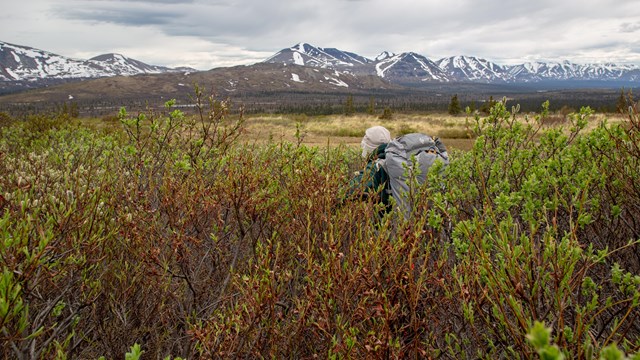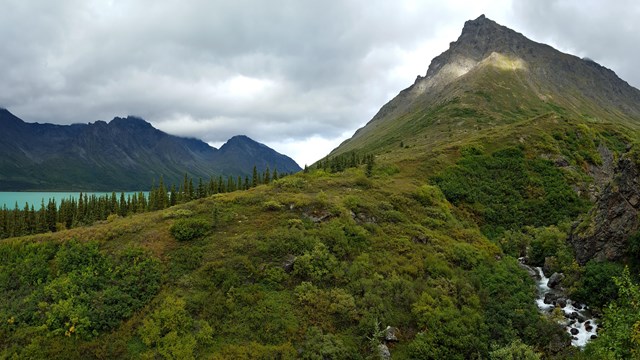|
Explore some of Dick Proenneke's stomping grounds by hiking into the valley above his cabin. With four million undeveloped, wild acres to explore there are countless places go for adventure, solitude, and recreation in Lake Clark. Part of the purpose of the park is to allow for individual, personal exploration of wilderness; therefore, the only maintained trails are the Tanalian Trails near Port Alsworth. This page only describes the general terrain in the valley above Proenneke's cabin; it does not describe in detail the exact route you should walk. Instead, we encourage you to use the information provided to plan your own unique trip. This off-trail route can be expanded, linked with other routes, or simply used to get an idea of the terrain. Adventurers in Lake Clark will need to rely upon way-finding, map-reading, and trailless hiking skills to navigate, or hire a guide who can help. 
Photo by A. Lindholm MapsUSGS 1:63 360 series topographic Lake Clark C3 & C2AccessFly in and out of Upper Twin Lake. A float or amphibious plane is required in order to land on Upper Twin Lake in the summer, as it does not have beaches suitable for a wheeled plane to land. Planes operating on wheels or skis may land on the lake in the winter if ice conditions are suitable.Time1-2 days, depending on how much time you spend exploring or relaxing.DifficultyGentle to moderate hiking on an unmaintained trail, then through trailless low brush and alpine terrain.HighlightsSpectacular views of mountains and lakes. Abundant blueberries, crowberries, and lowbush cranberries in season. Dall's sheep are sometimes visible on the high mountain slopes.HazardsWildlife including brown bear and black bear, mosquitoes and biting flies, and uneven terrain that can be slick when wet. It's possible to extend this route up and over a variety of passes. Passes can be very rocky and steep.Campsites and Food StorageThe only places to camp along the Hope creek route are in the alpine tundra closer to the end of the valley. You will need to store your food and toiletry items in approved bear resistant canisters during this trip due to the lack of trees to hang food where suitable camping is available. Canisters can be rented for free at the park visitor center in Port Alsworth. You should also cook at least 100 yards away from your camp to avoid an association made by bears between your camp and your food. Please follow leave no trace ethics and park rules and regulations when choosing campsites, storing food, and building campfires.Route DescriptionRoute begins on a trail from the Proenneke site leading up the Hope Creek Valley. The Hope Creek Valley is the significant drainage SE of the cabin. The trail fades away after a mile or two. Beyond the trail you'll encounter low brush and alpine hiking. It's possible to do this trip as an out and back, and there are numerous side valleys worth exploring. The Hope Creek Valley eventually climbs more steeply onto rocky moraine and onto a glacier at the head of the valley. You may also want to use the Hope Creek route as a starting point for a longer route that could utilize any number of passes to the west toward Low Pass (see Low Pass route description), southeast into the Upper Kijik drainage, or north into a drainage that flows back to Upper Twin Lake. These passes can be quite rocky and steep.
Backpacking in Alaska
Get acquainted with what makes backpacking in Alaska unique and familiarize yourself with these backcountry tips before you plan your trip. 
Hope Creek Route Photos
Images taken from along the Hope Creek Route. |
Last updated: December 19, 2018
